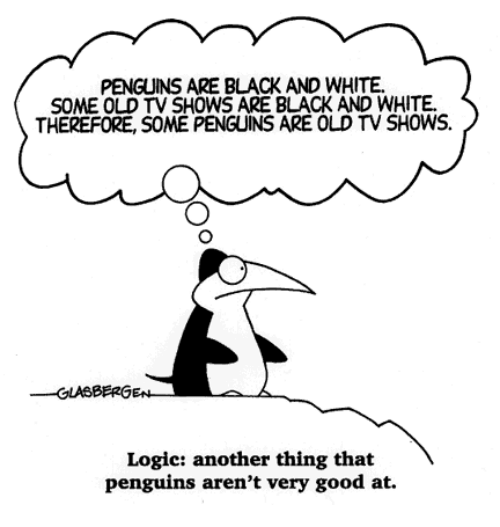Worksheet 2.2 Logic and Sets Group Activity
Propositions and Truth Values, Sets and Venn Diagrams
1.
Discuss each statement and decide which are propositions. Circle or highlight them.
Are you hungry?
Janae was nominated for student council president.
Four pounds less.
\(\displaystyle 7 + 8 = 33\)
I have two siblings.

2.
A proposition is given, represented by the letter \(p\text{.}\) Write the wording for the negation and double negation. (Note: \(\text{not}\ p\) can also be represented in symbols by \(\neg p\text{.}\))
\(p\text{:}\) Hannah eats apples.
\(\text{not}\ p\text{:}\)
\(\text{not not}\ p\text{:}\)
3. More negations.
Read the following and decide whether logging will continue. “The House failed to overturn a veto on a bill that would stop logging.”
4.
Complete the truth table given the following propositions. Then explain what you ate for breakfast in each case.
| \(p\) | \(q\) | \(p\ \text{and}\ q\) | Explanation—What did you eat for breakfast? |
| |
|||
| |
|||
| |
|||
| |
5.
The following proposition has the form \(p\) and \(q\text{.}\) Decide whether each part is true or false and whether the entire proposition is true or false.
6.
Determine whether each or statement is inclusive or exclusive.
Are you going to wear pants or a skirt tomorrow?
Students can join the Music Club if they are in the choir or band.
7.
Given the conditional statement, complete the truth table. Refer to your notes for help if needed. (Note: “if \(p\text{,}\) then \(q\)” can be written in symbols as \(p\to q\text{.}\))
“If I am elected, then I will reduce college tuition in Oregon.”
| \(p\) | \(q\) | if \(p\text{,}\) then \(q\) \(p\to q\) |
Meaning—Have I told the truth? |
| |
|||
| |
|||
| |
|||
| |
8. Building a Complete Truth table.
Separate the first column into half true, half false.
Repeat the process in each proposition column with groups half that size, until the last proposition alternates T-F.
Find entries for the other columns.
Two proposition table:
| \(p\) | \(q\) | \(p\) and \(q\) | \(p\) or \(q\) | if \(p\text{,}\) then \(q\) |
9. Pizza Truth Table, a three-proposition truth table.
Let \(P\) represent pepperoni, \(H\) represent ham, and \(M\) represent mushrooms.
(a)
Fill in the first three columns of the truth table using the pattern described in Worksheet Exercise 2.2.8. The first column should be half true and half false. Then go by twos, and then alternate.
(b)
Then complete each row by determining whether each statement is true or false. Don't worry about the meaning yet.
| \(P\) | \(H\) | \(M\) | \(P\) and \(H\) | \(H\) or \(M\) | \(P\) and \(H\) and \(M\) | not \(P\) | not \(M\) | not \(P\) or not \(M\) |
(c)
Now that you have the table filled in, identify the row for each type of pizza given.
Pepperoni and Mushroom Pizza: Row
Cheese Pizza: Row
Veggie Pizza (peppers, onions, mushrooms, olives): Row
Supreme Pizza (ham, pepperoni, sausage, olives, mushrooms, onions, peppers): Row
(d)
Explain the result (T or F), in the context of the pizza and its toppings.
(i)
Row 8 Column 9
(ii)
Row 3 Column 4
Sets and Venn Diagrams
10. Pizza Venn Diagrams.
Let's continue the last example with \(P\) representing pepperoni, \(H\) representing ham, and \(M\) representing mushrooms. Shade or color in the appropriate area(s) for each pizza on the Venn diagrams below.
Pepperoni & Mushroom
Cheese
Veggie
Supreme
11. Relating Truth Tables and Venn Diagrams.
| \(P\) | \(H\) | \(M\) | Type of Pizza |
Letter on the Venn Diagram |
| T | T | T | |
|
| T | T | F | |
|
| T | F | T | |
|
| T | F | F | |
|
| F | T | T | |
|
| F | T | F | |
|
| F | F | T | |
|
| F | F | F | |
Qualified Propositions
12.
Draw a Venn diagram for each qualified or categorical proposition. Then write on the line whether the sets are disjoint, overlapping, or one is a subset of the other.
Venn Diagram |
Relationship between the Sets |
|
Some bikes are orange. |
|
|
All bicycles have wheels. |
|
13. Interpreting values on a Venn diagram.
A survey was taken to see which professional sports were watched by students. Let \(F\) represent football, \(B\) represent basketball, and \(H\) represent hockey. Answer the following questions (use complete sentences). Show any calculations that were used.
(a)
How many students participated in the survey?
(b)
How many students watched basketball?
(c)
How many students watched only one of the sports?
(d)
How many students watched at least two sports?
(e)
How many students didn’t watch hockey?
(f)
How many students watched football and hockey, but not basketball?
14. Finding values for regions on a Venn diagram.
\(150\) people attending a concert were asked if they played piano, guitar, or drums.
- \(10\) could play all three.
- \(73\) could play guitar.
- \(18\) couldn’t play any of these instruments.
- \(21\) could play piano and drums.
- \(49\) could play at least two of the instruments.
- \(13\) could play piano and guitar but not drums.
- \(69\) could play drums or guitar but not piano.
Let \(P\) represent piano, \(G\) represent guitar, and \(D\) represent drums. Calculate and fill in the values for all eight regions.